This project was carried out with the invaluable collaboration of

and

please see a full listing of all contributors at the bottom of this post

the very first prototype consisted of an stainless steel AM base with forged carbon composite weights
Project Outline
One of the AEDG students, Wian van Aswegen, is a keen amateur golfer of some considerable ability, and late in 2020 discussions began on creating a customizable golf putter that could be additively manufactured, with minimal post-processing...the idea being that the serious golfer could specify their own desired configuration on a base design to rapidly produce a golf putter that was honed to their tastes ad needs.
The putter would be configurable iro lie angle, mass, face balance, weights, material, centre of gravity, sound and aesthetics to cover most issues that golfers are pernickity about.
Design of the putter's conceptual shape thus began in late 2020, and continued through 2021 - this is the story of the WvA Golf Putter...
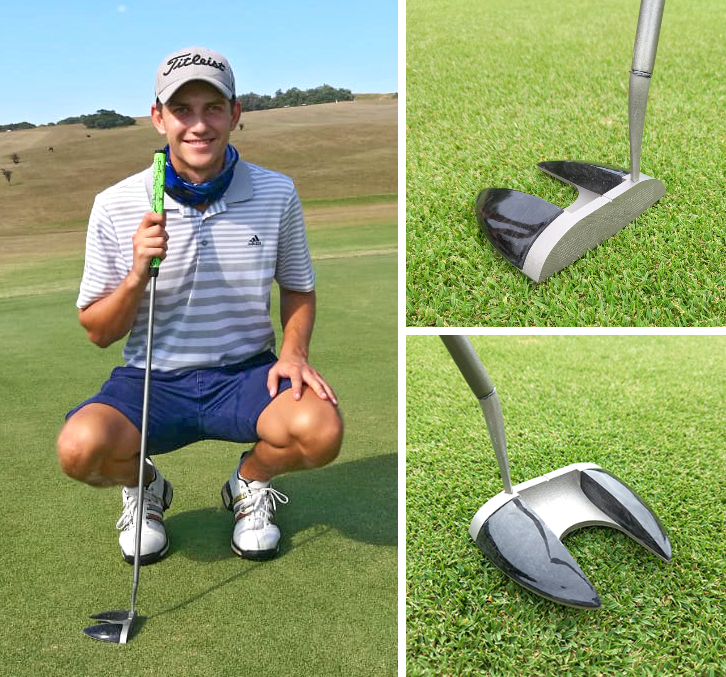
Wian pictured above with the first prototype on the greens of the Royal Port Alfred Golf Course
Overview
Additive Manufacturing (AM) has lately been a very hot topic and having the option to integrate research opportunities with sports equipment development was a task that drew a lot of excitement. Instantly the first thought was to have a look at the golf club that golfers most frequently use, the putter.
Traditionally, golf putters are milled from a solid stainless-steel block into the final product and this process is completely autonomized which caters for the mass production of a few selected designs. The introduction of AM allows putters to be crafted with minimal material wastage and various configurations can be printed simultaneously.
Everyone’s body mechanics and personal aesthetic and feel preferences differ. Therefore, ideally the golfer would go for a club fitting to ensure that they have the best combination of putter specifications to suit their putting stroke. This allows the golfer to have a putter that is specific to them in terms of loft, lie angle, mass, weight distribution, shape, size and groove pattern in order to achieve their optimized performance.
With the use of modern designing software platforms and metal 3D printers, the design can be adapted and printed withing a matter of days. The high quality of 3D printing done by the EOS M290 printers at Rapid3D allows for near limitless designing options to be available and the need for post processing is near non-existent.
The main targeted group are professional and serious amateur golfers as they would find more benefit from the complete customization that the AM putter provides. The capabilities of the EOS printers provide for a wide range of metals to be chosen from. Therefore, the designs can consist of various materials to achieve the desired weight and feel that the golfer is looking for.
As golfers are picky individuals and often change their minds, the incorporation of interchangeable weights allows for small adjustments to be made to the weight distribution after the putter has been constructed. With the assistance of CustomWorks, the weights in the initial metal printed putter were made from forged carbon composite which provided an aesthetically pleasing finished product that is also well balanced in terms of weighting.
Initial Design Concept
As this was a project that was started from a blank sheet of paper, a study of other popular modern putters was undertaken to draw some inspiration from and seeing how we can put our own spin on it.
The conceptualization stage stated in August 2020 and by September we had a few designs to choose from. The initial design was to feature stepper weights that can changed around and swapped out to achieve the ideal weight distribution for the golfer. However, this design provided issues with respect to the fastening of the weights as they have a few aspects that were a breach of the Royal and Ancient (R&A) rules of golf which would make the putter unfit for competition use.

the design concepts being honed down before final design
Later the stepped weights design was exchanged for latticing because the lattice can be adapted to create the golfers ideal weight distribution during the printing stage. The lattice is very aesthetic and has not been utilized much within the golfing industry. However, the practicality aspect thereof outweighed the aesthetic appeal. Firstly, the printing of the lattice is a challenge but most importantly dirt and sand will be lodged within the lattice which would be a struggle to remove and clean for the golfer.
Initial Prototype
Once we were happy with the design that we had at the time, we printed a plastic prototype in October 2020. This enabled us to have a look at the parts in physical form, and also dentify problem areas that are not necessarily evident on pure computational outputs. This prototype boosted our confidence tremendously as we were able to identify the few small issues that needed changing and act upon them all at once.
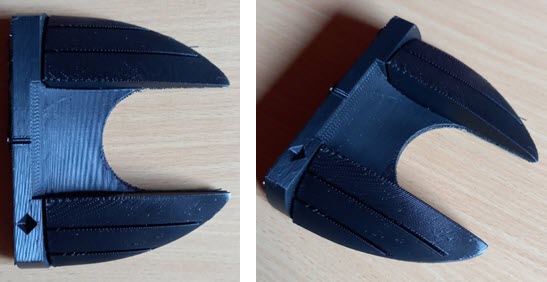
the initial rough print of the base with weights included
Final Base Design
As the targeted demographic are players with a fairly high skill level, their recognition of imbalances and misalignments are far more honed than the casual golfer. People often get fitted for the correct putter setup in Golfing Shops with their in-house Golf Pro’s, and the main priority of the fitting is to determine what length, lie angle and balance would be most beneficial for the individual.
The balance of a putter is a term used to describe where the centre of gravity of the putter head is in relation to the axis of the shaft. The three different types of balances are namely: face balanced, quarter hang and toe hang
In conjunction with a club fitting session, the golfer can specify the amount of hang that they would require to correlate with their respective stroke arc and face rotation. The correct hang will result in the golfer squaring up the putter more consistently, which in return will cause more putts to start on their intended line. This is entirely adaptable in this putter design.
The distribution of weight away from the centre towards the heel and toe of the putter will result in the increase of the Moment of Inertia (MoI) along the vertical axis. The higher the MoI value, the more consistency that will be present on off-centre hits.
Stability is the term used to describe the ability to have the putter repeatedly follow the intended stroke path, whilst maintaining a square putter face. With Additively Manufactured putter designs, the golfer has the choice to request more stability and forgiveness. This will be done by slight adaptations to the design to increase the MoI by shifting some mass away from the centre of the putter. However, this would not be advisable for golfers who have a lot of putter rotation in their stroke as the increased MoI will hinder their ability to return the putter face to square at impact.
The WvA putter consists of 3 main components namely the putter base, hosel and weights. All of these components are completely adaptable to suite the golfer’s specifications.
.png)
components of the putter head
Initial Print of the Putter Base
Early in December 2020 we received the first stainless steel printed putter base and hosel from Rapid3D and were once again blown away with the surface finish and detail that the EOS M290 printers could produce.
These was almost no need for post-processing and a few days later the fully assembled putter was ready to be put to the test.
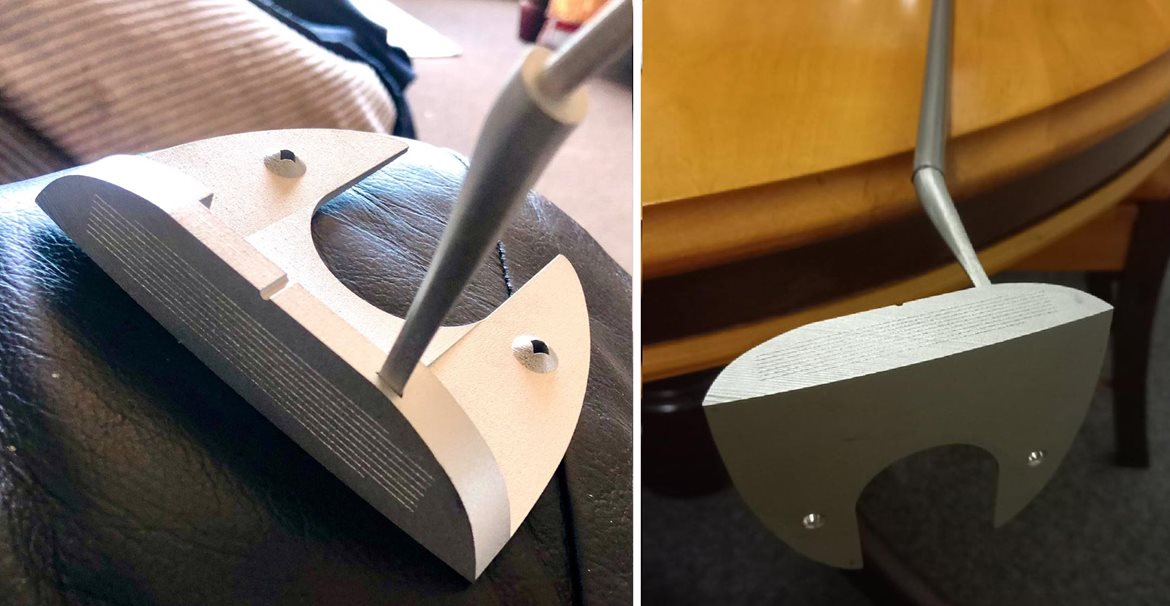
(l) the printed base and (r) the putter showing full face balance as per design intent
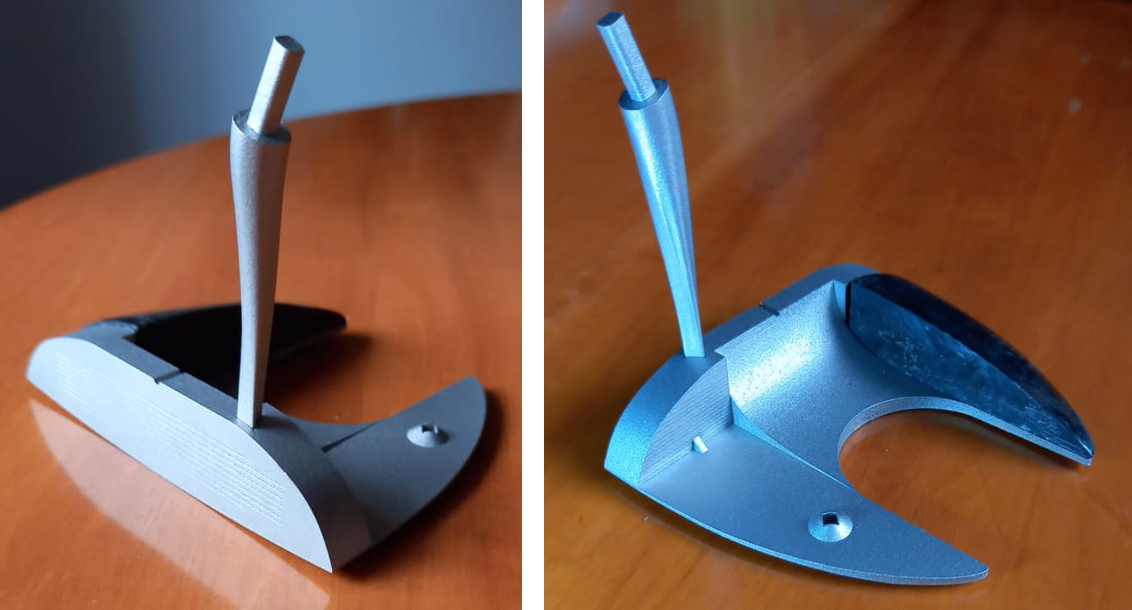
the first metal print received back from Rapid3D including the one forged composite weight
Forged Composite Weights
For the weights, we again collaborated with composite guru Arno Seyfert from CustomWorks in Jeffreys Bay.
We had done previous work experimenting on forged composite outputs (as popularized by Lamborghini) with some reasonable success, and it was envisaged that the weights in forged carbon composite would achieve the aesthetic, weight and machinability that would be needed by the putter weights.
In order to create the carbon composite weights, molds were designed and printed for the resin containing the carbon fibres to cure in while pressure was applied.
After a few hours, once the resin is fully cured, the weight is extracted from the molds, and finished to create the smooth surfaced for the clear coating to be added to add to the aesthetic.
Ideally the molds would be made from aluminium to ensure a better surface finish and to make it easier to remove the part from the mould but this is a very expensive option, so additively manufactured molds were created, and the output was very pleasing.
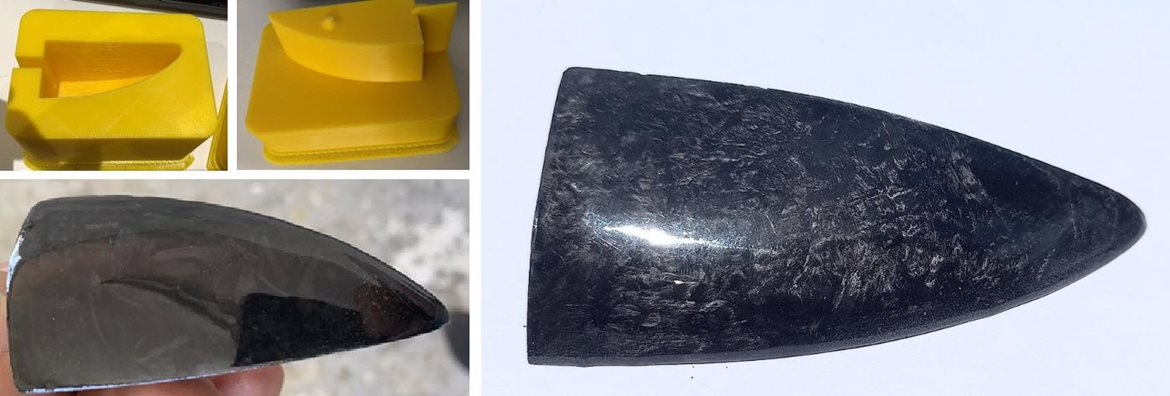
(left top) the printed molds, (left bottom) the extracted forged composite weight prior to finishing, (right) the finished article
Alignment Jig
To reduce support material, the hosel and putter base were printed separately, thus the hosel fits into the putter base and is glued to secure it. However, to accurately judge the lie angle of the putter is difficult to do manually while the glue is curing. Therefore, an alignment jig was designed and created to ensure that the lie angle would always be consistent while also making assembly much easier.
The current design of the shaft alignment jig has a lie angle of 71° to the horizontal because it is a good middle ground as the angle is commonly between 69° and 72°. The base and arm or the jig are separate components so three or four different arms can be interchanged to acquire the intended lie angle.
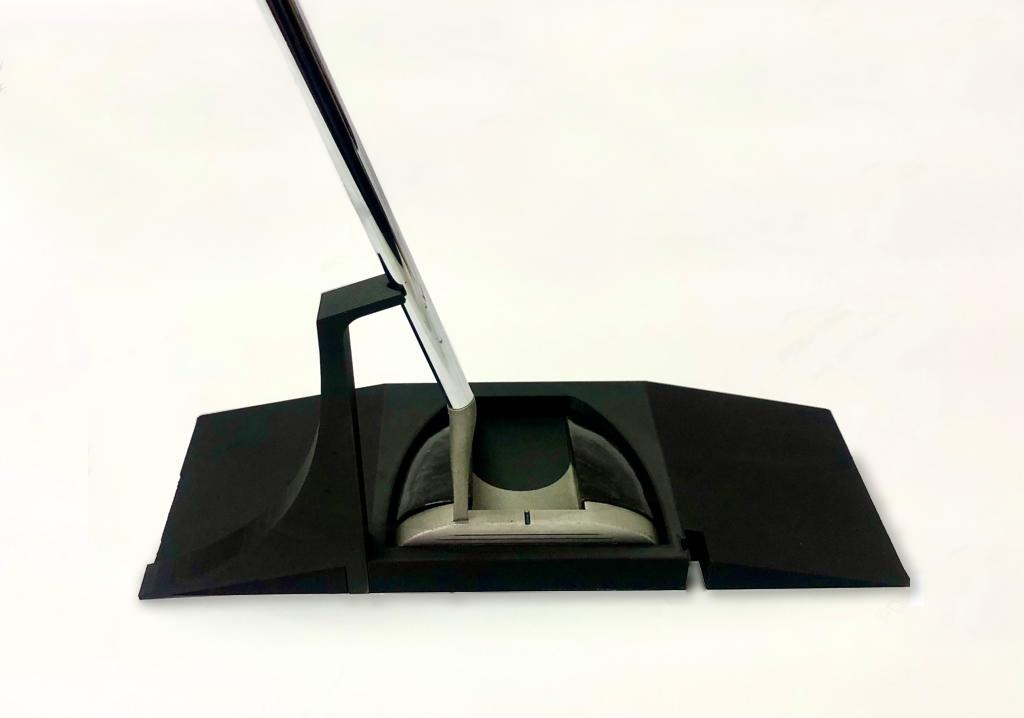
the lie angle jig with the putter inserted to ensure accurate alignment curing of the shaft and the putter head
3D Scanning of Comparative Putters
In order to create accurate comparisons between the WvA putter and other commonly used traditionally manufactured putters we contacted aNtSA to make use of their Creaform MetraSCAN 3D scanning equipment. This allowed us to create a workable part file from the physical object.

3D Scanning of Comparative Putters was carried out with assistance from eNtSA using their advanced MetraScan laser scanner
Analysis of Comparative Putters
Using the STL files aqcquired from the 3D scanning, the cloud data was transformed into a mesh and minor modifications made to create a a solid 3D CAD drawing of each putter. These part drawings were then used to run various simulations in order to compare the WvA putter design to other modern traditionally manufactured putters.

Comparative Analysis of Frequency Response on the Putters
The Scotty Cameron was chosen as the generic benchmark for the testing and the WvA Design is 15.67 [g] lighter. This difference is a relatively small change and each adaptation to the design will yield a change in mass. The use of different materials alone can create a mass range of 185-656 [g].
The loft of traditionally manufactured putters is normally predetermined by the manufacturer and therefore creating a very limited range. However, the WvA design allows the user to select their preferred loft between the range of 0° and 10°, as this range is regulated by the R&A Rules of Golf.
The WvA putter has a higher MoI compared to that of the other putters, which is beneficial to the performance of the putter. However, upon request the WvA putter design can be altered to satisfy a wide range of preferred MoI values.
Testing, Testing...
Wian has been playing golf competitively for many years and was able to use his golfing knowledge to create a putter that appealed to general feel preferences and performance requirements that most golfers have become accustom to.
He was also able to get a few of his golfing friends, that are amongst the top ranked amateurs in South Africa, to test the putter and provide much needed feedback. The feedback received was very positive as the golfers were impressed that the WvA putter had a satisfying feel and performed to the same level as what they expect from other high-end golf putters.
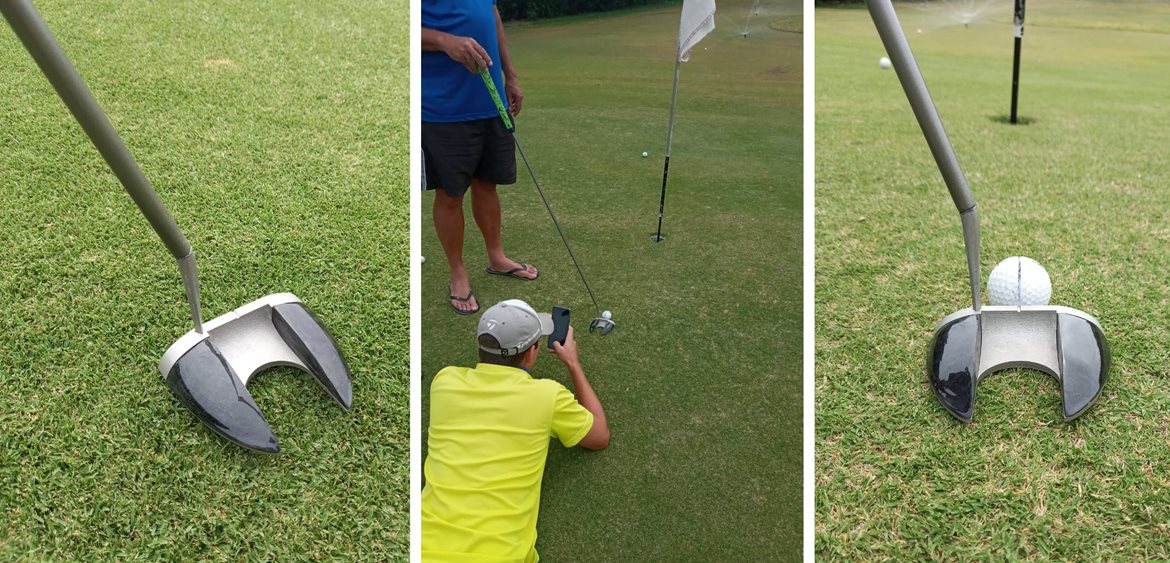
the initial completed prototype makes its debut on the Royal Port Alfred Golf Course links
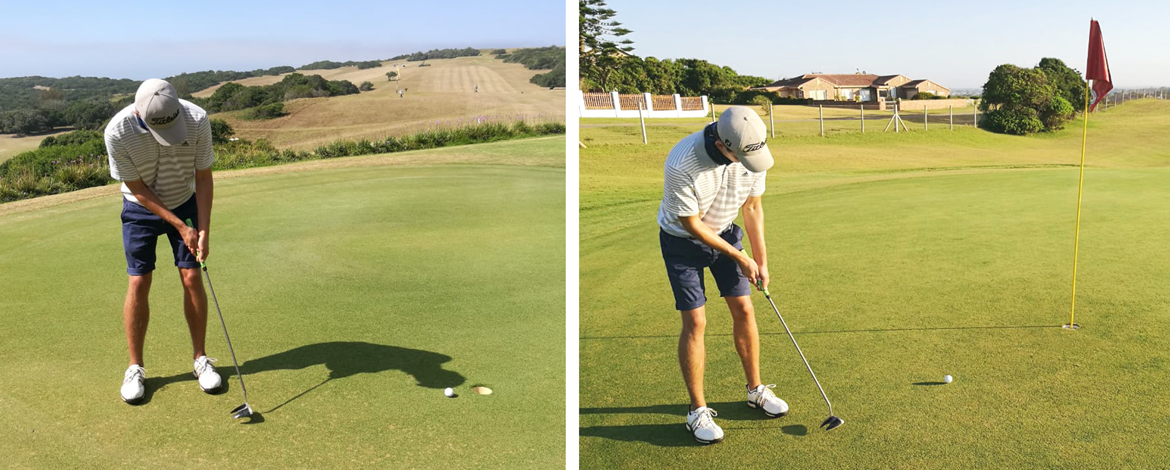
ONYX Weights
To demonstrates the range of options available, we used our in-house Markforged printers to print a few weights made from ONYX and incorporated a few patterns and symbols just to show off various aesthetics.

various aesthetic finishings on the ONYX weightds
Final Putter
Using the feedback received from the testing phase, further small adjustments were made to the design of the first metal printed WvA putter. The new design is slightly lighter and includes a custom logo.
In June 2021 the updated design to Rapid3D and shortly the final printed putter was ready to be assembled. After a bit of post processing, the final WvA putter was tested against the previous version.
The new WvA putter has a more refined weight distribution and face balance compared to the previous version and the slightly lighter mass is better suited for the fast putting greens that serious amateurs and professionals are accustomed to playing on.
The new WvA putter is also paired with different ONYX customizable weights that perfectly fit onto the putter base and also add to the aesthetic appeal.

the final completed putter was fitted with ONYX removable weights
Media
The WvA golf putter generated much interest among media, and there were several media articles published, and was even featured on the Luister FM radio station. Some of the published media items are depicted below:
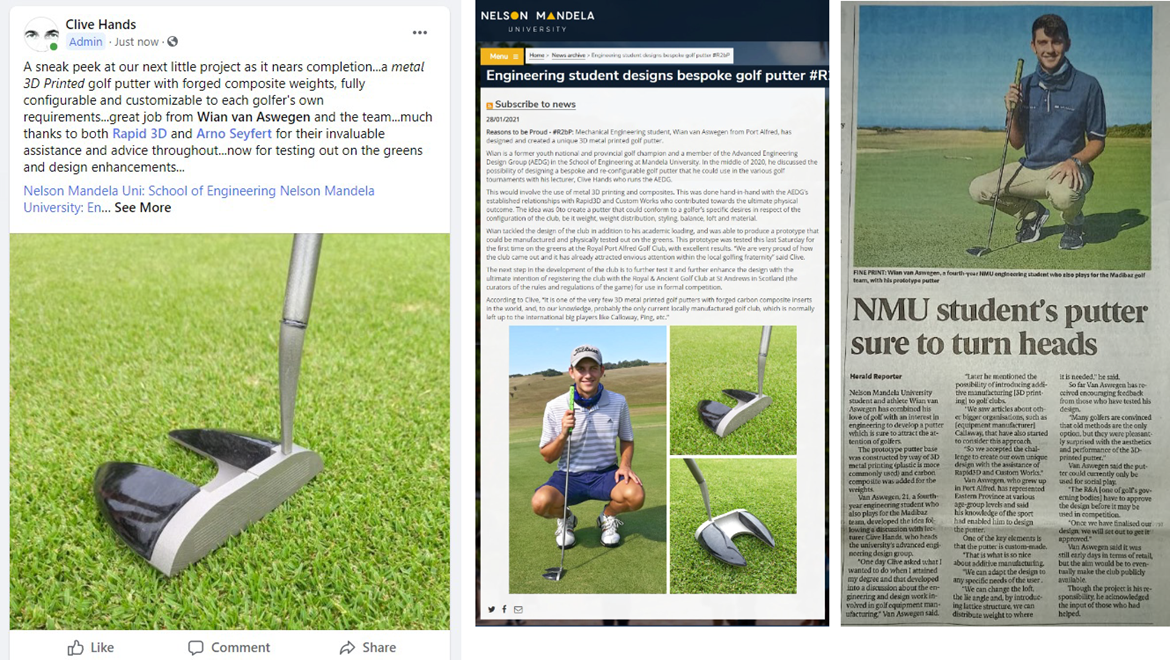

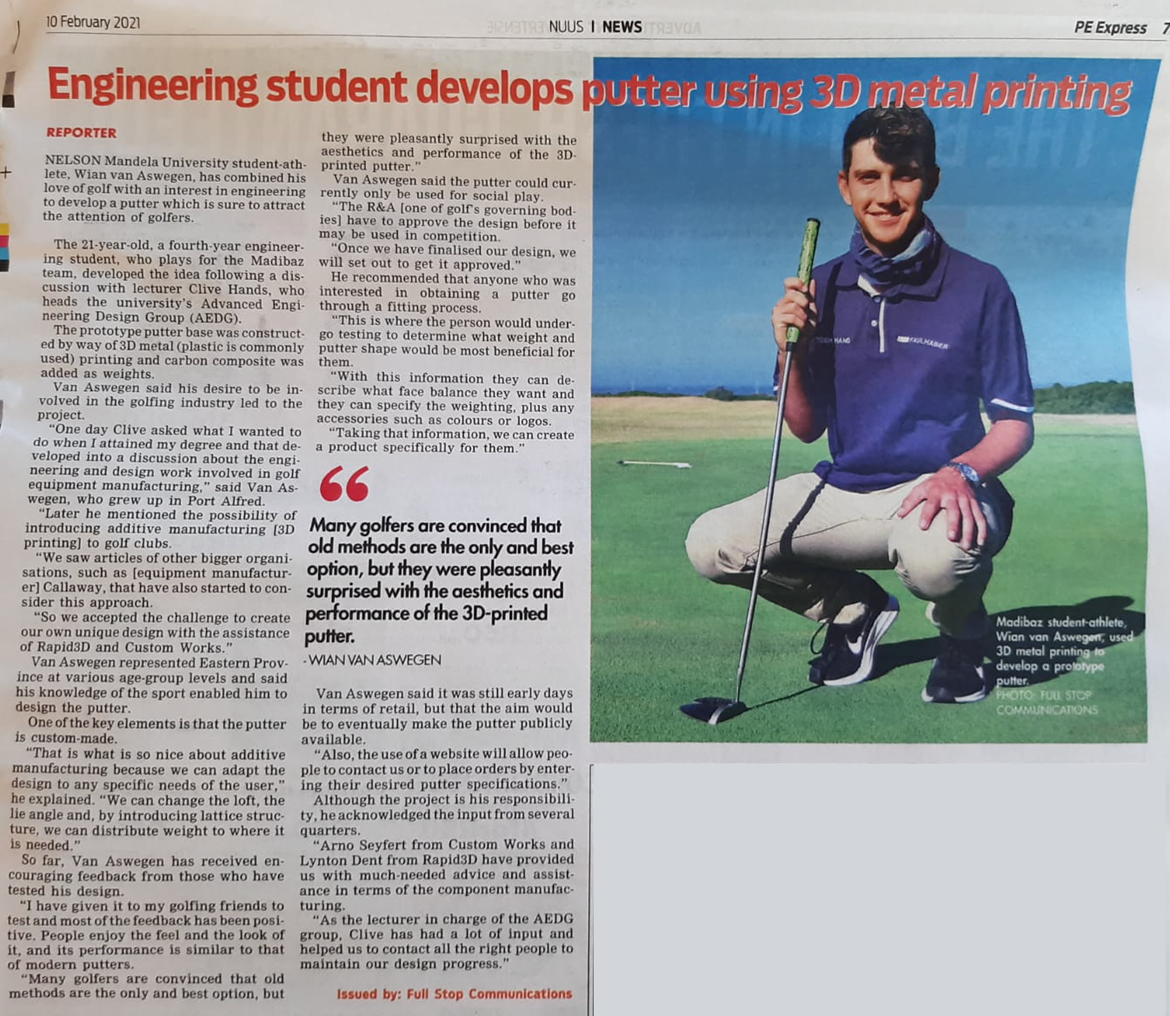
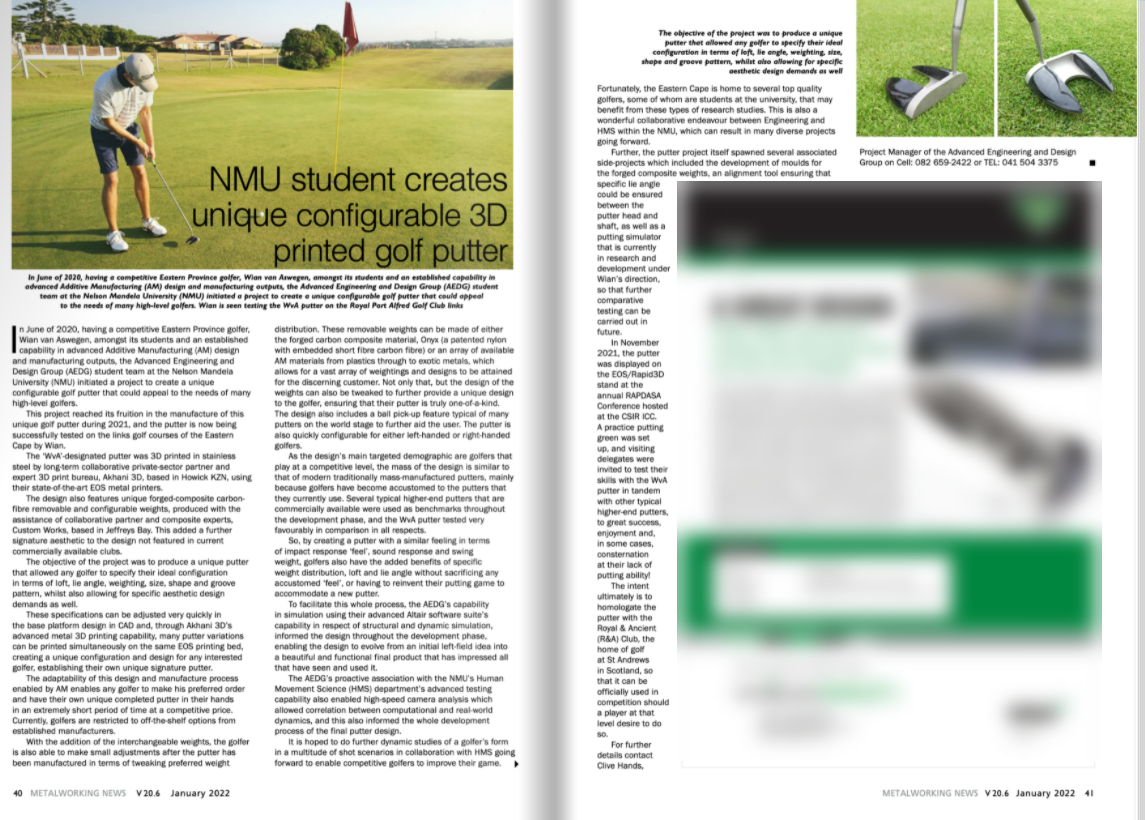
Events
The Golf Putter was presented as a paper and presentation at the 2021 RAPDASA Conference at the CSIR ICC in Pretoria. The AEDG team was hosted at the EOS/Rapid3D stand throughout the event - much appreciation to all at Rapid3D...
In addition to the golf putter being on display, the team also set up a practice putting green for delegates to try their luck, and to compare the feel of the WvA putter to other typical higher-end putters brought with. There were many favourable comments, and some significant competition between those trying it out for bragging rights!
Wian also presented his work to the delegates present on Day 2 of the Conference.

various photos from the 2021 RAPDASA Conference at the CSIR ICC where the putter generated much interest and competition
Contributors
Huge thanks & appreciation must go out to all these individuals for their completely selfless contribution to this, be it for information, advice, their time, their contacts, their services, or whatever contribution they made, no matter how big or small.
AEDG Team (Clive Hands, Wian van Aswegen, Zaahid Imran, Jode Fourie, Daniel Trask, Muhammad Lookmanjee)
NMU (Dr William Rall)
Rapid3D (David Bullock, Lynton Dent)
Custom Works (Arno Seyfert)